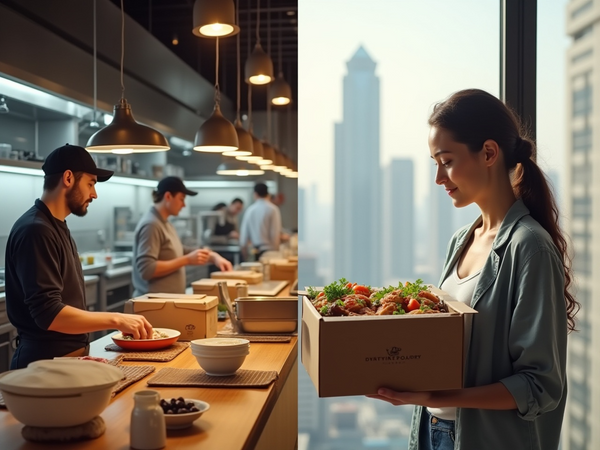Cloud Kitchens vs Subscription Meals: Which Model Fits You?
by JUSTINE YOLANDA

In today’s fast-moving world, people are split between two growing priorities: some crave convenience when it comes to food, while others are looking to cash in on the booming food delivery economy. Whether you're a busy professional tired of cooking or an entrepreneur eyeing the next profitable food trend, you're likely caught between two powerful models: cloud kitchens and subscription meal plans.
Cloud kitchens, also known as ghost kitchens or virtual kitchens, have redefined the restaurant business by eliminating dine-in operations and focusing purely on food delivery. On the other hand, subscription-based meal services offer pre-planned, pre-portioned meals delivered on a regular schedule giving users both time savings and dietary consistency.
But which model truly fits your needs or goals? Are you better off launching a delivery-only kitchen brand, or subscribing to a healthy weekly meal plan? This post breaks down both models from every angle: business viability, user convenience, market trends, cost structure and more.
By the end of this article, you’ll have a clear picture of which direction makes more sense for you whether you're a founder thinking of starting up in Dubai or a consumer looking for the easiest way to stay fed and fit.
What Is a Cloud Kitchen?
A cloud kitchen also known as a ghost kitchen, virtual kitchen, or dark kitchen is a delivery only food business model that operates without a traditional dine-in space. Instead of serving customers at tables, these kitchens fulfill online food orders placed through delivery apps or brand websites.
At its core, a cloud kitchen is designed to minimise overhead costs like rent, front-of-house staff and dining decor. The focus is 100% on food production, delivery logistics and scale. These kitchens often serve multiple virtual brands from a single location, maximising the use of equipment, ingredients and manpower.
How does it work? A cloud kitchen is typically located in an industrial or low-rent area. Orders come in via food delivery aggregators such as Talabat, Deliveroo, or Careem. The kitchen prepares the meals and hands them off to delivery drivers no walk-in customers, no storefront branding, just streamlined operations aimed at high-volume, fast-turnaround service.
This model has exploded in popularity due to its lower startup costs, faster time-to-market and adaptability. Entrepreneurs can launch multiple food brands from one kitchen without investing in multiple physical restaurants.
Examples in the UAE include:
-
Kitopi: One of the largest managed cloud kitchen platforms, operating across multiple markets.
-
Reef: A US-based operator expanding globally with delivery-only kitchens.
-
Talabat Kitchens: Partner kitchens designed to support online food-only brands with turnkey infrastructure.
Cloud kitchens are ideal for scaling food concepts quickly in urban, delivery-heavy markets like Dubai.
Pros and Cons of Cloud Kitchens
Cloud kitchens offer a lean, modern path to entering the food business, but they're not without serious trade-offs. Here’s a breakdown of the key advantages and drawbacks.
Pros
-
Low Startup & Operating Costs: No dine-in space means reduced rent, staffing and utility expenses.
-
Faster Time to Launch: Launch a food brand in weeks, not months, without the delays of restaurant permits and fit-outs.
-
Scalability: Easily replicate operations across multiple locations or cities with minimal overhead.
-
Run Multiple Brands from One Kitchen: Operators can manage different cuisines under separate brand names, maximising output from a single space.
-
Adaptability: You can pivot menus or brands based on data insights or seasonal trends.
Cons
-
Heavy Dependence on Delivery Aggregators: Relying on Talabat, Deliveroo, or Careem means paying steep commission fees (up to 30%).
-
Limited Brand Visibility: Without a physical storefront, you must work harder to build recognition and trust.
-
Operational Complexity: Managing logistics, packaging, rider delays and order volume spikes can be challenging.
-
Lack of Direct Customer Feedback: With no in-person interaction, you're missing out on valuable real-time input from diners.
Comparison Table: Cloud Kitchen vs Subscription Meals

Who Should Choose Cloud Kitchens?
If you’re an entrepreneur or restaurateur looking to enter the food delivery space with minimal overhead and maximum agility, cloud kitchens are likely your best bet. They’re also ideal for established food brands wanting to expand into new markets without the risk of opening physical locations.
Cloud kitchens cater well to a B2C model, especially in urban areas like Dubai, where food delivery is the norm. You can test multiple cuisines, launch virtual brands and use real-time data to optimise menus all from a single kitchen hub. With the right branding and aggregator partnerships, it’s possible to scale quickly and capture niche segments (e.g., vegan, comfort food, premium burgers).
This model suits:
-
First-time food business owners wanting low-risk entry
-
Existing restaurants expanding via virtual brands
-
Tech-savvy founders looking to build scalable food startups
-
Franchise operators aiming to centralise production and reduce physical footprint
However, success depends on efficient operations, strong delivery partnerships and a strategic approach to online visibility. Without dine-in footfall, digital marketing becomes your lifeline.
Who Should Choose Subscription Meals?
Subscription meal plans are ideal for individuals and households who prioritise convenience, health and routine. If you’re a busy professional, health-conscious individual, or part of a family juggling work and parenting, this model is tailored for your lifestyle.
Instead of spending time shopping, prepping, or deciding what to eat, users receive pre-portioned, often customised meals delivered regularly daily or weekly. This appeals to people who want to stay consistent with their diet (e.g., keto, vegan, high-protein), without the hassle.
This model also works well for:
-
Fitness-focused users needing macro-controlled meals
-
Working parents who want healthy meals without daily cooking
-
Elderly or solo households preferring predictable, portioned meals
-
Corporate wellness programs offering meal subscriptions to employees
For businesses, subscription meals are a B2C lifestyle-driven opportunity, offering high retention rates and recurring revenue. It does require strong logistics, customer service and personalisation tech to maintain satisfaction and reduce churn.
If your value proposition is nutrition, convenience, or health consistency, this is the model to invest in.
Trends in Dubai & UAE: Which Model is Growing?
The UAE has become a hotspot for both cloud kitchens and subscription meal services driven by a young, tech-savvy population, growing health consciousness and a thriving food delivery culture. But each model is growing at a different pace and in different ways.
Cloud kitchens are seeing massive B2B investment, with players like Kitopi securing millions in funding and expanding across multiple markets. Talabat Kitchens is scaling rapidly by offering turnkey facilities to virtual food brands, helping them launch with minimal friction. These models are built for speed, scalability and platform integration making them especially attractive to entrepreneurs and food startups targeting delivery-first consumers.
Subscription meals, on the other hand, are experiencing strong consumer-side growth, particularly in wellness-centric urban demographics. Brands like Basiligo, Right Bite and Kcal Extra are seeing a rise in demand from customers looking for curated nutrition, weight loss, or performance-driven meal plans. These companies often personalise meals using health data, making the model more "sticky" over time.
Current dynamics in the UAE suggest:
-
Cloud kitchens are dominating the food startup ecosystem, attracting venture capital and international attention.
-
Subscription meals are gaining traction among health-aware residents, especially expats and professionals with disposable income.
-
Hybrid models are emerging and some cloud kitchens are launching meal plan offerings to diversify revenue.
-
Verdict: Both models are growing, but cloud kitchens are scaling faster due to investor interest, while subscription models offer deeper customer loyalty and lifestyle alignment.
What’s Right for Your Lifestyle or Business?
Both cloud kitchens and subscription meal plans offer compelling benefits but which one fits you depends entirely on your goals.
If you're an entrepreneur or food brand looking to launch or scale in the delivery economy, cloud kitchens offer a flexible, low-cost entry with huge potential for growth. They're ideal for testing multiple cuisines, leveraging third-party platforms and building scalable virtual brands. The trade-off? You’ll face aggregator dependency and operational complexity.
On the other hand, if you're a consumer seeking convenience, health consistency, or lifestyle support, subscription meals are the better fit. They save time, reduce decision fatigue and offer personalised nutrition. However, you'll need to manage the risk of meal fatigue and higher upfront commitment.
Looking ahead, both models are evolving fast. Tech integration, automation and data-driven personalisation are shaping the future of food delivery. Expect to see hybrid models where cloud kitchens also offer subscriptions, or meal plans powered by virtual kitchen infrastructure.
Ultimately, whether you're building a business or simplifying your life, the right choice comes down to how you value time, control, scale and experience.
Frequently Asked Questions (FAQs)
1. What is the difference between a cloud kitchen and a traditional restaurant?
A cloud kitchen operates without a dine-in facility, focusing solely on delivery. Traditional restaurants offer both dine-in and delivery, which increases costs related to space, staff and customer service.
2. Are meal subscriptions more affordable than cooking?
It depends on your lifestyle. While subscription meals may cost more than bulk home cooking, they save time, reduce food waste and often eliminate impulse spending on groceries or takeout.
3. Can I run a cloud kitchen from home in the UAE?
Running a commercial kitchen from home is not permitted in most UAE emirates. You’ll need to register your business, meet hygiene regulations and operate from an approved kitchen facility or rent space in a licensed cloud kitchen.
4. Who benefits most from subscription meal services?
Busy professionals, health-conscious individuals and families looking for convenience and nutritional consistency are ideal candidates for subscription-based meal plans.
5. Are cloud kitchens profitable in the UAE?
Yes, especially in urban hubs like Dubai and Abu Dhabi. With high demand for food delivery, low overhead costs and rising digital adoption, cloud kitchens can be highly profitable with the right execution.



